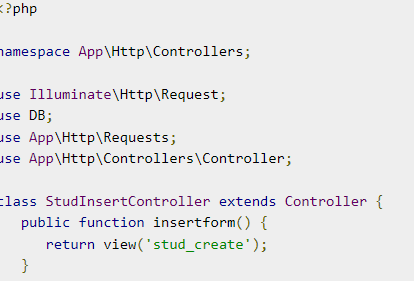Updated February 21, 2023

Introduction to Laravel Insert
Larvel is executed on PHP and a web framework that is free and available as an open-source. It is primarily used for developing customized web applications using PHP and a web framework to manage multiple things like authentication, routing, and templating in HTML. It is completely on the server-side, which executes on PHP and manages the complexities of data manipulation and fixing to the model-view-controller design. It is similar to the react framework, which focuses mostly on user interaction. This article explains the laravel insert function in the database and gives an overview of Laravel.
What is a laravel insert?
Laravel is the best web framework executed in PHP and other frameworks in distinct languages. On the server-end render framework, Rail is used effectively and is similar to Laravel and based on Ruby. Angular, Vue, and React work on the client-end, and the framework of Javascript is configured to render on the server-end. If the user application works towards a blogging style with different text-based portfolios, it is based on WordPress and executed on PHP. But here, Laravel does not force the user to use the unrequired features; it offers the tools to develop some reliable and effective tools by the user itself.
How to use the laravel insert?
The user can insert the record in the database by using the insert method, which has the standard syntax to follow,
Syntax:
bool insert ( string $ query, array $ binding = array () )The parameters are $ query in a string format, a query to be executed in the database.
The $ binding, which is in the array format used as a value to be bound with queries.
It returns the bool function, and the description can be filled to execute the insert statement against the database.
Laravel insert data:
To insert data in Laravel, the following steps need to be executed.
Execute the following commands to build a controller called stud insert controller
The following output is obtained once it is created successfully without any bugs.
Copy the below code to the new file:
app / http/ controllers/ studinstert controller.php
app / http/ controllers/ studinstert controller.phpThen create a view file known as resources/ views/ stud_new.php and copy the code to the file.
resources/ views/ stud_new.phpInsert the below command in the file app/ HTTP/ routes.php
Navigate to the app/ HTTP/ routes.php URL to add the record to the database.
Then the required output is displayed in the below image.
Laravel insert data Framework
The insert data to the table is made in Laravel by the following methods. It is simple in Laravel 7 and can be executed with complete information, source code, and examples.
The laravel database query is also used to insert the laravel query in MySQL. The PHP framework works effectively to insert the data into the database. First, the user must create a database table to insert data. Then he should use Insert Into statement to add the raw data to the Mysql table in the required database.
Statement for INSERT INTO:
INSERT INTO name of the table (columnA, columnB, columnC,.....)
VALUES (value01, value02, value03,.....)It will be easy to use Laravel if the user knows SQL
The SQL query to create a table and table member details is as follows,
Create Table_member_details
CREATE TABLE_member_details
(
id int NOT NULL AUTO_INCREMENT,
profile _nm varchar(30),
real _nm varchar(30),
full _address varchar(30),
email_address varchar(30),
primary key (id)
}Then create three new files to insert the data in Laravel.
Member insert controller.php – it is located under /app /HTTP/Controllers/ Member insert controller.php
Member_create .php – it is located in resources-views – member_create .php
Website.php – it should be located in routes -> website.php
To view the file, execute the following query
<!DOCTYPE html>
<html>
<head of the document>
<title>member addition | Add</title>
</head of the document>
<body>
@if (session('status of the query'))
<div class="alert alert-success" role="status of the alert">
<type of the button ="button" name of the class="close" data-dismiss="alert">×</button>
{{ session('status of the alert') }}
</div>
@elseif(session('failed'))
<div class="alert alert-danger" role="status of the alert">
<type of the button ="button" name of the class="close" data-dismiss="alert">×</button>
{{ session('failed') }}
</div>
@endif
<form action = "/create new" method = "post">
<type of the input = "hidden" name = "_token" value = "<?php echo csrf_token(); ?>">
<table>
<tr>
<td> First Name </td>
<td> <type of the input ='text' name='profile_nm' /></td>
<tr>
<td> Last Name </td>
<td> <input type="text" name='real_nm'/></td>
</tr>
<tr>
<td> Name of the city </td>
<td>
<select name="complete_address">
<option value="cca"> Calcutta </option>
<option value="ngp"> Nagpur </option>
</select> </td>
</tr>
<tr>
<td> Email address </td>
<td><type of the input ="text" name='email'/></td>
</tr>
<tr>
<td span = '2'>
<itype of the input = 'submit' value = "Insert member"/>
</td>
</tr>
</table>
</form>
</body>
</html>Add the script for the controller file.
<?php
namespace App \Http \Controllers;
use App \Member Insert;
use Illuminate \Http \Request;
use \Illuminate \Http \Response;
use Illuminate \Support \Validator;
use Illuminate \validate \policy;
class Member Insert Controller extends Controller
{
public function insert()
{
$data of the url = getURLList();
return view('Member _create new');
}
public function create(Request $request)
{
$policy = [
'profile_nm' => 'required|string|min:4|max:245',
'complete_address' => 'required|string|min:4|max:245',
'email address' => 'required|string|email|max:245'
];
$validator = Validator::make ($request->all(),$rules);
if ($validate->fails())
{
return redirect('insert')
->withInput ()
->withErrors ($validate);
}Then the model file should be executed as a query
After, the routes file should be executed as a query
<?PHP
/*
|--------------------------------------------------------------------------
| Web Routes
|--------------------------------------------------------------------------
|Here the user can save the web route for the application, and they are loaded in the route service provider inside the group, which comprises the web middleware group.
|
|
*/
//insert the data
Route:: get ('insert','Member InsertController@insertform');
Route:: post ('create','Member InsertController@insert');Conclusion
If the user wants to insert a huge amount of data into a database in Laravel, it can be implemented effectively with the help of the Laravel 6 version. Hence, the brief discussion of inserting data in Laravel is explained, and the user can work on it effectively.
Recommended Articles
This is a guide to Laravel Insert. Here we discuss the laravel insert function in the database and give an overview of Laravel. You may also look at the following articles to learn more –





